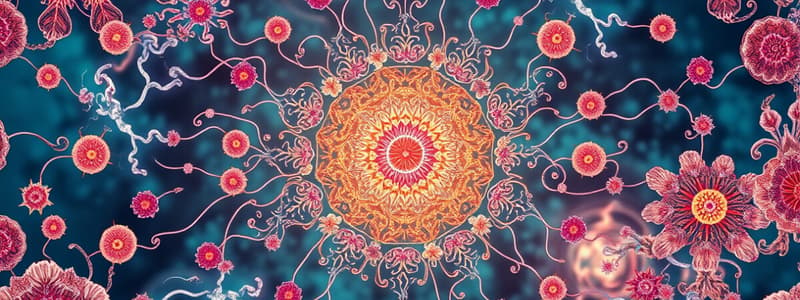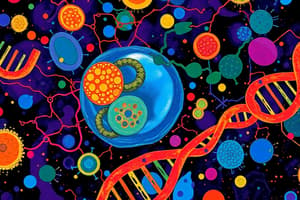Podcast
Questions and Answers
Which type of molecule is identified as more efficient catalysts?
Which type of molecule is identified as more efficient catalysts?
- Lipids
- Nucleotides
- Polypeptides (correct)
- Carbohydrates
What do present-day cells primarily rely on for catalysis?
What do present-day cells primarily rely on for catalysis?
- Proteins (correct)
- Nucleic acids
- Lipids
- Carbohydrates
What is the primary genetic code based on in modern cells?
What is the primary genetic code based on in modern cells?
- Amino acids
- Polynucleotides (correct)
- Cartilage
- Proteins
What hypothesis suggests that RNA played both catalytic and encoding roles?
What hypothesis suggests that RNA played both catalytic and encoding roles?
Which of the following is required for nucleic acid synthesis?
Which of the following is required for nucleic acid synthesis?
Which process requires the genetic code to specify amino acid order?
Which process requires the genetic code to specify amino acid order?
What ability of polypeptides is in question regarding replication?
What ability of polypeptides is in question regarding replication?
What system is hypothesized to have originally played both catalytic and encoding roles?
What system is hypothesized to have originally played both catalytic and encoding roles?
What are membrane-bound organelles characteristic of?
What are membrane-bound organelles characteristic of?
What is primarily responsible for separating a cell from its external environment?
What is primarily responsible for separating a cell from its external environment?
What is a significant component of a prokaryotic bacterial cell's cell wall?
What is a significant component of a prokaryotic bacterial cell's cell wall?
Which feature of the cell wall provides protection for the cell?
Which feature of the cell wall provides protection for the cell?
Which type of cell does not have membrane-bound organelles?
Which type of cell does not have membrane-bound organelles?
What is the primary function of the cell membrane?
What is the primary function of the cell membrane?
What do both prokaryotic and eukaryotic plant cells share in terms of structure?
What do both prokaryotic and eukaryotic plant cells share in terms of structure?
What is the nature of the material that makes up prokaryotic cell walls?
What is the nature of the material that makes up prokaryotic cell walls?
What is a primary role of imaging tests in health sciences?
What is a primary role of imaging tests in health sciences?
Which of the following best describes prokaryotic cells?
Which of the following best describes prokaryotic cells?
What aspect of biochemistry is highlighted in the provided content?
What aspect of biochemistry is highlighted in the provided content?
How does the transportation analogy relate to cell activities?
How does the transportation analogy relate to cell activities?
What is a key benefit of understanding health and disease at the molecular level?
What is a key benefit of understanding health and disease at the molecular level?
What distinguishes eukaryotic cells from prokaryotic cells?
What distinguishes eukaryotic cells from prokaryotic cells?
Which of the following statements about organelles is true?
Which of the following statements about organelles is true?
What is a common feature of both prokaryotic and eukaryotic cells?
What is a common feature of both prokaryotic and eukaryotic cells?
What is found in the internal mitochondrial matrix?
What is found in the internal mitochondrial matrix?
What type of DNA is found in mitochondria?
What type of DNA is found in mitochondria?
How big are mitochondria compared to bacteria?
How big are mitochondria compared to bacteria?
What is a plausible origin of mitochondria?
What is a plausible origin of mitochondria?
What are the two forms of endoplasmic reticulum?
What are the two forms of endoplasmic reticulum?
What feature is characteristic of the rough endoplasmic reticulum?
What feature is characteristic of the rough endoplasmic reticulum?
Where is the endoplasmic reticulum attached?
Where is the endoplasmic reticulum attached?
What gives the endoplasmic reticulum the appearance of a double membrane in electron micrographs?
What gives the endoplasmic reticulum the appearance of a double membrane in electron micrographs?
What is the primary focus of biochemistry?
What is the primary focus of biochemistry?
What can be inferred about the complexity of living organisms?
What can be inferred about the complexity of living organisms?
How do biochemistry and life processes interconnect?
How do biochemistry and life processes interconnect?
Which of the following statements is true regarding cells?
Which of the following statements is true regarding cells?
What aspect of life does biochemistry NOT specifically study?
What aspect of life does biochemistry NOT specifically study?
In what way does biochemistry contribute to understanding biology?
In what way does biochemistry contribute to understanding biology?
What can be said about the relationship between biochemistry and cellular organization?
What can be said about the relationship between biochemistry and cellular organization?
How does biochemistry help in the origin of living things?
How does biochemistry help in the origin of living things?
Flashcards are hidden until you start studying
Study Notes
Biochemistry and Life Processes
- Biochemistry serves as a key to understanding human body functions and life processes.
- Complex organisms, including humans, are composed of diverse and complex cells.
- Interdisciplinary nature of biochemistry allows integration of insights from multiple scientific fields.
Applications in Health Sciences
- Knowledge of molecular health and disease enhances treatment efficacy across various illnesses.
Cellular Organization
- Cell activities can be likened to a city's transportation system, where molecules act like vehicles.
- Prokaryotic and eukaryotic cells differ significantly in structure and organization.
Prokaryotic and Eukaryotic Cells
- Prokaryotic cells lack membrane-bound organelles, while eukaryotic cells possess them.
- Prokaryotic DNA is organized without a nucleus, and there are differences in the nature of their cell walls.
Cellular Structures
- Plasma membrane serves as the boundary separating the cell from its environment, composed of lipids and proteins.
- Prokaryotic cells are often encased in a rigid cell wall made primarily of polysaccharides, providing protection.
- Mitochondria are energy-producing organelles found in eukaryotic cells, containing their own DNA and ribosomes resembling those in bacteria.
Endoplasmic Reticulum (ER)
- The endoplasmic reticulum is a single-membrane system that forms a network throughout the cell.
- Rough ER is distinguished by ribosomes, while smooth ER lacks them, serving different functions within the cell.
Studying That Suits You
Use AI to generate personalized quizzes and flashcards to suit your learning preferences.




